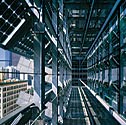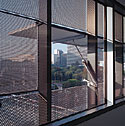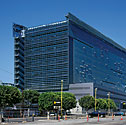Robo Buildings: Pursuing the Interactive Envelope
Stick-built robotics
For many architects, the European tradition of customizing an off-the-shelf, unitized, double-wall product presents a safe and effective entrée into the world of interactive facades. Less prevalent is the craft-based approach used by Thom Mayne for Caltrans District 7 Headquarters in Los Angeles, which opened in late 2004. There, Morphosis Architects pulled apart the envelope's functional elements, "redelegated" them, and coordinated their job-site "reassembly" among seven exterior subcontractors, says project leader Pavel Getov.
The result combines a large photovoltaic array and independently controlled, automated elements within a multiple-layer facade. The prominent shading layer of perforated metallic panels on east and west facades cuts initial solar heat gain by about 15 percent. The screen hangs about 1 foot from the slab edges of a weather-wall of metal framing, gypsum sheathing, and PVC membrane. In this way, the intervening space functions partly as convective cavity. One thousand or so of the scrim panels, corresponding to ribbon windows behind, open or close daily. Those on the east close in the morning, those on the west in the afternoon. For longevity, the architects specified stainless-steel hardware and a single pneumatic lift per panel, rather than the pair of electrical actuators originally considered. A rooftop sensor signals the panels to close during high winds.
According to Getov, 3D modeling and mock-up testing ensured the performance of the stick-built envelope under wind, rain, and seismic conditions. The firm shared a single building-information model among consultants and manufacturers, and component prototypes made on a 3D printer. Still, says Getov, "A lot of the design is resolved through the mock-ups." Even with extensive reviews and site visits for the customized, kinetic countenance, the project penciled out at $165 per square foot, including finished interiors and design fees-about the same as an average office building. The building's small facade area in relation to its floor plate accounts in part for the cost-effectiveness. Energy savings are projected at about 40 percent. Getov's advice for architects interested in the process seems counterintuitive.
"The small manufacturers can be the most helpful because they don't already have a set solution in place," affording architects more conceptual control and collaboration, he explains. "It allows you to break down the process."












